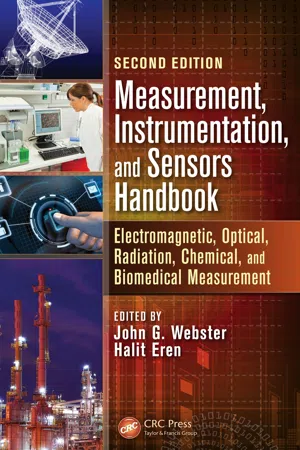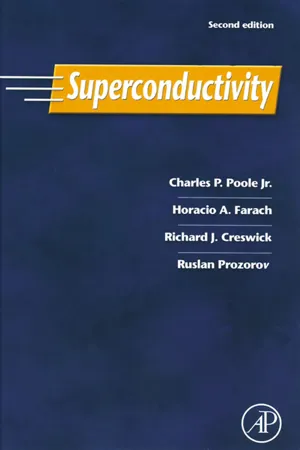Physics
Null Resistivity
Null resistivity refers to the absence of electrical resistance in a material. This means that the material can conduct electricity without any loss of energy. This phenomenon is observed in superconductors at very low temperatures.
Written by Perlego with AI-assistance
Related key terms
Related key terms
1 of 4
Related key terms
1 of 3
6 Key excerpts on "Null Resistivity"
- eBook - ePub
Measurement, Instrumentation, and Sensors Handbook
Electromagnetic, Optical, Radiation, Chemical, and Biomedical Measurement
- John G. Webster, Halit Eren, John G. Webster, Halit Eren(Authors)
- 2017(Publication Date)
- CRC Press(Publisher)
2 ].On a microscopic level, electricity is simply the movement of electrons through a material. The smaller white circle in Figure 26.1 represents one electron flowing through the material. For ease of explanation, only one electron is shown. There are usually many electrons flowing through the material simultaneously. The electron tends to move from the left side of the material to the right side because an external force (represented by the large minus and plus signs) acts on it. This external force could be due to the voltage produced by an electrical power plant or a battery connected to the material. As the electron moves through the material, it collides with the “stationary” atoms of the material, represented by the larger black circles. These collisions tend to slow down the electron. This is analogous to a pinball machine. The electron is like the metal ball rolling from the top to the bottom of a pinball machine, pulled by the force of gravity. The metal ball occasionally hits the pins and slows down. Just like in different pinball machines, the number of collisions the electron has can be very different in different materials. A material that produces many collisions is a high-resistivity material. A material that produces few collisions is a low-resistivity material.The resistivity of a material can vary greatly at different temperatures. The resistivity of metals usually increases as temperature increases, while the resistivity of semiconductors usually decreases as temperature increases. The resistivity of a material can also depend on the applied magnetic field.FIGURE 26.1Simple model of electricity flowing through a material under an applied voltage. The white circle is an electron moving from left to right through the material. The black circles represent the stationary atoms of the material. Collisions between the electron and the atoms slow down the electron, causing electrical resistivity. - eBook - ePub
- Yoseph Bar-Cohen(Author)
- 2016(Publication Date)
- CRC Press(Publisher)
Electrical resistivity is a measure of the resistance of a material to the flow of an electric current, and it is a related to how readily a material allows the travel of electric charge. The inverse of the electrical resistivity is the electrical conductivity or specific conductance and it is the measure of a material’s ability to conduct an electric current. According to the Wiedemann–Franz law [Kittel, 2005], the thermal conductivity in metals approximately tracks the material electrical conductivity, since freely moving valence electrons transfer both electric current and heat energy. For nonmetallic materials, this correlation of the electrical and thermal conductance does not hold due to the increased role of phonon carriers for heat transfer.4.2.4.1 Semiconductors
A semiconductor is a pure crystalline material that has electrical conductivity with a value between those of a conductor and an insulator. The low conductivity in semiconductors is attributed to the limited number of charge carriers more than to impurity or phonon scattering. The electrical conductivity of semiconductor materials decreases with the reduction in temperature and is opposite to the response of metallic conductors. The properties of semiconductors are explained by the movement of electrons and holes inside a lattice and can be made to have variable resistivity. The electrical properties of a semiconductor material can be modified by controlled addition of impurities. The conduction of current is done by charge carriers consisting of moving free electrons and “holes” [Berman, 1976]. Adding impurity atoms to a semiconducting material, that is, “doping,” greatly increases the number of charge carriers. A doped semiconductor that contains mostly free holes is called “p-type,” and a semiconductor with mostly free electrons is called “n-type.” The n- and p-types are the key elements of electronic devices including diodes and transistors.4.2.4.2 Superconductors
A superconductor is an element, intermetallic alloy, or compound that conducts electricity without resistance when it is cooled below a characteristic critical temperature [Rose-Innes and Rhoderick, 1978]. Generally, the electrical resistivity of a metallic conductor decreases as the temperature is lowered, but in superconductors, at the critical temperature, the resistance drops abruptly to zero. In ordinary conductors such as copper or silver, this decrease is limited by impurities and other defects. An electric current flowing through a loop of superconducting wire can continue indefinitely with no need for a power source. The quantum mechanical phenomenon of superconductivity was discovered in Leiden, Holland, on April 8, 1911 by Heike Kamerlingh Onnes [Laesecke, 2002]. The phenomenon is characterized by the Meissner effect, which is the complete ejection of magnetic field lines from the interior of the superconductor as it transitions into the superconducting state. - eBook - ePub
Quantum Physics
A Beginner's Guide
- Alistair I. M. Rae(Author)
- 2005(Publication Date)
- Oneworld Publications(Publisher)
6Superconductivity
In Chapter 4 we saw that, because electrons can behave as waves, they can pass through a perfect crystal without bumping into the atoms on the way. Provided, as in a typical metal, there are empty states available, the electrons will respond to an applied field and a current will flow; whereas in an insulator the presence of an energy gap means that there are no such empty states and therefore no current flow. We also saw that in practice, the current flow through a metal experiences some resistance because all real crystals contain imperfections associated with the thermal displacement of atoms from their normal positions in the crystal and the replacement of some of the atoms by impurities. In this chapter we shall discuss another class of substances, known as ‘superconductors’, in which resistance to current flow completely disappears and electric currents, once started, can flow indefinitely. Ironically, we shall find that this behaviour also results from the presence of an energy gap that has some similarities to, as well as important differences from, the energy gap that prevents current flow in an insulator.Superconductivity was discovered, more or less by accident, by a Dutch scientist, Kamerlingh Onnes, in 1911. He was conducting a programme of measurement of the electrical resistance of metals at temperatures approaching absolute zero, which had recently become accessible thanks to technological developments in the liquefaction of gases. Helium, in particular, liquefies at only a few degrees above absolute zero at normal pressure and can be cooled even further by reducing its pressure using vacuum pumps. Onnes found that the resistance of all metals decreases as the temperature is lowered, but in most cases there is still some resistance to current flow at the lowest temperatures available and, by inference, at absolute zero (this is illustrated in Figure 6.1 ). We can understand this behaviour in terms of the model we developed in Chapter 4 - eBook - ePub
- Charles P. Poole, Horacio A. Farach, Richard J. Creswick, Ruslan Prozorov(Authors)
- 2010(Publication Date)
- Academic Press(Publisher)
c is in the linear region.Figure 2.14 Resistivity-versus-temperature plot obtained by Kamerlingh Onnes when he discovered superconductivity in Leiden in 1911.A Resistivity Drop at T c
Figures 2.3a , 2.3b , 2.7 , and 2.8 show the sharp drop in resistance that occurs at T c . We will see later in the chapter that there is an analogous drop in susceptibility at T c .A susceptibility measurement is a more typical thermodynamic indicator of the superconducting state because magnetization is a thermodynamic state variable. Resistivity, on the other hand, is easier to measure, and can be a better guide for applications. Generally, the T c value determined from the resisitivity drop to zero occurs at a somewhat higher temperature than its susceptibility counterpart. This is because any tiny part of the material going superconductive loses its resistance, and R = 0 when one or more continuous superconducting paths are in place between the measuring electrodes. In contrast, diamagnetism measurements depend on macroscopic current loops to shield the B field from an appreciable fraction of the sample material, and this happens when full superconducting current paths become available. Therefore, filamentary paths can produce sharp drops in resistivity at temperatures higher than the temperatures at which there are pronounced drops in diamagnetism, which also require extensive regions of superconductivity. Such filamentary behavior can be described in terms of percolation thresholds (Gingold and Lobb 1990 ; Lin, 1991 ; Phillips, 1989b ;Toledano et al ., 1990;Zeng et al - Javier E. Hasbun, Trinanjan Datta(Authors)
- 2019(Publication Date)
- CRC Press(Publisher)
c even if the metallic sample may have impurities. In 1911, Kamerlingh Onnes observed such an effect in mercury.Figure 12.2.3: Persistent current in a superconducting ring.Figure 12.2.4: Field versus temperature plot of type I and type II superconductor.Table 12.3.3: Critical temperatures and critical fields (Hc(0) or Hc2(0)) at T = 0 K for some elemental Type I and Type II superconductors. For Type II superconductors, the upper critical field value is stated. Source: [57 ]SuperconductorTypeTc(Kelvin)Critical field (MA m−1 ) Hg I 4.15 0.033 Pb I 7.19 0.064 Nb I 9.25 0.158 NbTi II 9.6 11.94 Nb3 AlII 18.7 25.78 Nb3 (AlGe)II 21 35.01 12.3 Zero Electrical ResistanceIn Figure 12.2.2 we displayed the resistivity behavior difference of a metal and a superconductor. In general the electrical resistivity of metals and alloys decreases when cooled. Upon cooling a specimen of the metal or alloy, the lattice vibrations subside and the conduction electrons experience less scattering. For a perfectly pure sample, the resistivity should approach zero as the temperature tends towards zero Kelvin. Note, this is not the phenomenon of superconductivity. In reality, there are no perfect samples and most specimens will have some impurities. In this case the electrons will be scattered by impurities leading to a residual resistivity as shown in Figure 12.2.2 . However, there are certain metals which display the remarkable behavior that their resistivity first decreases and then completely vanishes below a critical temperature value. The phase transition to the superconducting state occurs even if the metal is impure, which from our previous discussion would have resulted in a large residual resistivity. Thus, the superconducting state is not just a metal with zero resistance, but, is a distinct electronic phase of matter.12.4 Persistent CurrentThe most convincing evidence that superconductors have zero resistivity is the observation of a persistent current. In experiments carried out in a coil of Nb0.75 Zr0.25 with magnetically induced persistent currents and observed via NMR, it was estimated that the decay time is greater than 105 years! To provide a description of persistent currents based on the laws of electrodynamics, consider the closed loop of superconducting wire shown in Figure 12.2.3- eBook - ePub
- Mary Anne White(Author)
- 2018(Publication Date)
- CRC Press(Publisher)
Part IVElectrical and Magnetic Properties of MaterialsRodney Cotterill The Cambridge Guide to the Material WorldThe missing link between electricity and magnetism was found in 1820, by Hans Christian Ørsted, who noticed that a magnetic compass needle is influenced by current in a nearby conductor. His discovery literally set the wheels of modern industry in motion.Passage contains an image
12
Electrical Properties
12.1 Introduction
Although all the properties of materials—optical, thermal, electrical, magnetic, and mechanical—are related, it is perhaps the electrical properties that most distinguish one material from another. This distinction can be as simple as metal versus nonmetal, or it can involve more exotic properties such as superconductivity. The aim of this chapter is to expose the principles that determine electrical properties of matter.12.2 Metals, Insulators, and Semiconductors: Band Theory
The resistance to flow of electric current in a material, designated R , is determined by the dimensions of the material (length L and cross-sectional area A ) and the intrinsic resistivity (also known as resistivity , and represented by ρ) of the material:*R = ρ(L A)( 12.1 )where R is in units of ohms† (abbreviated Ω) and ρ is typically in units Ω m. The intrinsic resistivity depends not just on the specific material but also on the temperature. (We will see later how the temperature dependence of resistivity can be used to produce electronic thermometers.) Some typical resistivities are given in Table 12.1 .TABLE 12.1 Electrical Resistivities, ρ, and Conductivities, σ (= ρ−1 ), of Selected Materials at 25 °CThe electrical conductivity , σ, of a material is the reciprocal of its resistivity, ρ:σ =1 ρ( 12.2 )so typical units of σ are Ω−1 m−1 (≡S m−1 , where S represents Siemens* and 1 S = 1 Ω−1 ). Electrical conductivity also can be equivalently expressed in terms of current density, J (units A m−2 , where A is amperes† ) and electric field, ε (units V m−1 , where V is volts‡
Index pages curate the most relevant extracts from our library of academic textbooks. They’ve been created using an in-house natural language model (NLM), each adding context and meaning to key research topics.
Explore more topic indexes
Explore more topic indexes
1 of 6
Explore more topic indexes
1 of 4





